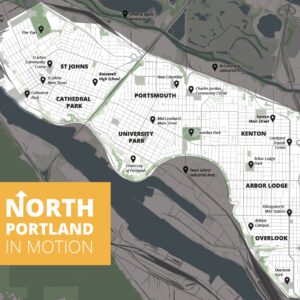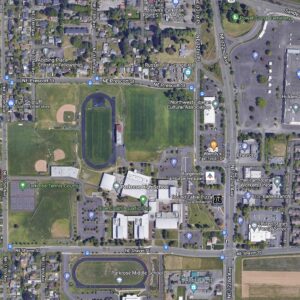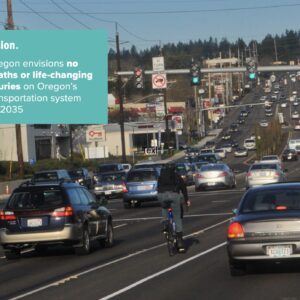Tomorrow, the BTA will release a statement that outlines their response to the recent rash of bike/car collisions in the Portland metro area. I have received advanced permission to publish this press release to the bike community here on BikePortland.org.
The release of their “Five Part Plan” follows their recent Op-ed that ran in the Oregonian and it reinforces their commitment to cyclist’s rights.
- (1) Identification of, and advocacy for, site-specific engineering safety improvements.
They will visit crash scenes and advise city engineers on how to make them safer. - (2) Advocacy for appropriate enforcement actions.
Make sure the guilty party receives a punishment equal to the crime. - (3) Expanded driver and cyclist education efforts.
They will work to add bicycle awarenss to the DMV’s driver’s ed. test. - (4) Improved identification of dangerous areas.
They will ask the city to fund an online, interactive crash reporting system. - (5) Advocacy for a fair share of safety funding for bike and pedestrian projects.
They will lobby for more equal representation for cyclists in transporation funding.
Continue reading for the full release…
NEWS RELEASE:
Bicycle Transportation Alliance Announces
Plan in Response to Cyclist Deaths
For Immediate Release August 9, 2005
Contact: Evan Manvel, Executive Director, 503-226-0676 x 12
In response to the Portland-area bicyclist fatalities this summer, the Bicycle Transportation Alliance has called for a comprehensive community response to the recent bicycle fatalities, and announced its own five-part plan of action.
“While bicycling has become safer over time, we need to make sure we’re doing all we can. Everyone in the community needs to do their part to make sure our friends, neighbors, and family members will be safe when they choose to bike,” said Evan Manvel, Executive Director. “The Bicycle Transportation Alliance is a natural leader in the effort to ensure that we share our roads safely. We’ve been doing a lot, but we’re planning on doing even more.”
As the state’s leading bicycle advocacy organization, many of the BTA’s programs promote bike safety. The BTA has lobbied for new laws, pushed for high-quality bike facilities, taught over 25,000 kids how to bike safely, provided resources to new adult bike commuters, and run a variety of public education efforts, including a bimonthly legal clinic for cyclists.
In response to the five recent fatalities in the Portland area, the BTA has set up a staff “crash team”, wrote an article about how the community should respond (read it at www.bta4bikes.org), and created its own five-part plan to reduce future crashes, and related injuries and fatalities.
The BTA’s plan:
(1) Identification of, and advocacy for, site-specific engineering safety improvements. The BTA’s crash team will review crash sites in the Portland Metro area and make recommendations to transportation departments on how to improve bike safety with engineering changes.
(2) Advocacy for appropriate enforcement actions. The BTA’s crash team will work with police departments and district attorneys’ offices and call for proper citations and charges in response to crashes.
(3) Expanded driver and cyclist education efforts. The BTA is working to expand its existing share the road education effort (see www.easytoshare.com). It is also working to improve the Department of Motor Vehicles’ education efforts, including expanded information in the Oregon Drivers’ Manual.
(4) Improved identification of dangerous areas. The BTA is asking the City of Portland to fund a web-based crash reporting system to identify dangerous areas, drawing on the experience of the ghostcycle.org database.
(5) Advocacy for a fair share of safety funding for bike and pedestrian projects. The BTA is calling for bike and pedestrian facilities in Oregon to receive Federal highway safety improvement money in proportion to the number of bikes and pedestrians that are killed. In the most recent data reviewed (2001-02), 14% of the fatalities in Oregon were pedestrians and bicycles, yet none of the Federal money earmarked for highway safety projects was spent on bike-pedestrian focused improvements. The BTA will advocate for a law requiring a fair share in the 2007 Legislature, and will lobby for individual projects until then.
While the recent deaths have received significant community attention, leading some to worry about safety, bicycling is becoming safer as more people bike. The number of bikeway miles and the number of cyclists have more than tripled since 1990, while the number of fatal crashes has remained relatively constant.
If members of the public are interested in volunteering with the BTA’s crash team, or have other suggestions on how to make biking safer in our region, e-mail the BTA at info@bta4bikes.org or call (503) 226-0676.
The Bicycle Transportation Alliance is a non-profit grassroots organization creating healthy, sustainable communities by making bicycling safer, more convenient and more accessible. The BTA works to protect and promote the rights of cyclists on the grassroots and legislative levels, and educates kids and adults about safe and legal bicycling.
For more information about the BTA, please visit www.bta4bikes.org.
###





I don’t understand why motorists cannot see us bicyclists. I commute from Woodstock to downtown and it is a challenge not to get run-over. I ride on out-of-the-way roads that are designated bike routes and use flashing lights during the day. But still, people pull out right in front of me, push me off the road, cut me off, and turn without looking. It is a dangerous ride!
The eye seems to see what it is most looking for and tunes out the rest. People in cars are looking for other cars and sometimes don’t see the bike that is approaching. Increasing bicycle awareness in the mind of the general public will help this.
Meanwhile–always put the odds in your favor: commute at safer times, take safer routes, wear bright clothing, make eye contact with drivers, cover your brakes in all dubious situations, and generally ride as defensively and alertly as possible.
I’m a big fan of the BTA and all the advocacy work they do, and I’m glad to see them taking on this important work as well. This initiative can only help make us cyclists more visible to motorists and in the consciousness of the general public. The staff at the BTA have obviously been paying attention to the concern and the recent conversations in the bicycle and the wider communities and I applaud them for taking this on.
I’m also happy to see them utilizing the experience of other grassroots groups such as ghostcycle.org. Connecting bike group to bike group will make the whole community and network that much stronger.
I think this is a good start. I particularly like that funding for
bike-related improvements and driver education are on the list. The
fair-share law is long overdue. Kudos to BTA for going after this
one. That said, I’d like to know a little more about the accidents
that occured this year before assessing it too much..
Specifically, were the cyclists obeying the rules of the road? Were
they wearing helmets? For those of us who ride and race regularly,
these 2 points are habit. From what I can recall, I don’t believe any
of the 5 riders killed on the road this year were wearing helmets. I
may be wrong. We need to work on this. Driver culpability was well
addressed in the 5-point plan – that’s why I’m addressing cyclists
only here.
First, I’d like to see a major push in the community for cyclist
education about the rules of the road and our rights as riders. The
plan mentions making this part of driver’s ed. I’d argue that many of
the riders in my neighborhood (and around Portland) are riding bikes
either because they don’t have a license, or because they lost it
(DUI). In either case, they’re not going to get the information. Driver’s
ed is merely one avenue of many to get the information out. We
need to find a non-confrontational way of getting the rider safety
message out en masse.
I’d like to see the police have the ability to ticket people riding
improperly (on sidewalks, against traffic, etc). Every day I see
officers drive by poeple on bikes riding the wrong way down sidewalks
I have yet to see one stop. This leads me to believe they either
don’t care or don’t have the means for enforcement. If the law does
not provide that ability or is vague about where/how to ride, some
clarification may be in order. Bikes are a vehicle – let’s start
treating them as such legally. On the flipside, we have to be careful
not to make life difficult for people riding – we want to remain a
bike-friendly community, and having law enforcement appear hostile to
riders won’t help there.
Second, we need to approach the issue of helmets. I know Oregon has a
long and heated past with helmets and motorcycles, and I don’t want to
stir up the hornet’s nest here. Oh…why not.
This entire summer I can count on one hand the number of riders I’ve
seen wearing helmets. And I see hundreds of bikes go by my house
every week. I don’t buy the “I’m and adult, it’s my choice, it’s my
life” argument. When you get hit by a car and end up in the hospital
with a head injury and no health insurance, it becomes my problem.
Should we look into a helmet law for all riders? I think so. Would
it pass? I doubt it. Doesn’t hurt to try.
Thanks for the read. (Dons flame-retardant gear).
Ah, helmets. Beacons of protection that will stretch out a field around a rider, preventing cars from hitting them with their shocking, mystical powers.
—
I think the most important thing here is how to avoid automobile-bicycle collisions. Both types of vehicles need to behave in predictable ways and respect each other’s use of the road. I like the points the BTA points out; specifically, including cyclists’ rights within the DMV-produced drivers’ manuals would be a great step. Any day I ride on particular 4-lane roads, in the lane, drivers shout obscenities at me, occasionally spitting or throwing objects. Many attempt to intimidate me by making dangerously close, illegal passes with their vehicles. I’d like them to know — and like the legal community as well as people as a whole — to recognize that action as assault with a deadly weapon.
Vehicular homicide is a BAD thing, guys and gals.
If one of them WERE to hit me, 2 to 4 TONS of automobile at 40 to 60 miles an hour aren’t going to be phased much by 9 ounces of styrofoam. I’m still dead.
A few years ago KATU interviewed me for a bike car awareness segment, it was a great way to communicate to drivers as they are not likely to be reached through bike advocacy channels. I think this should become a weekly part of a local news program with Portland being the most greatly populated bike city I have lived in. Allowing cyclist to voice the shear numbers of unattentive drivers on the road. Expose’s on drivers talking on phones and the multitude of distracting non driving related activities motorists engage in could get right to the heart of the problem. Plan and simple drivers are not paying attention, this is just unnacceptable and in my opinion is criminal and should be treated as such.